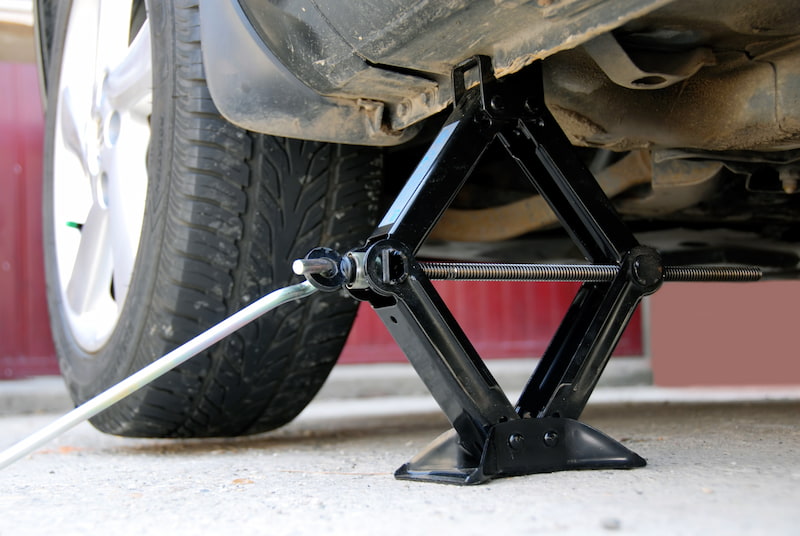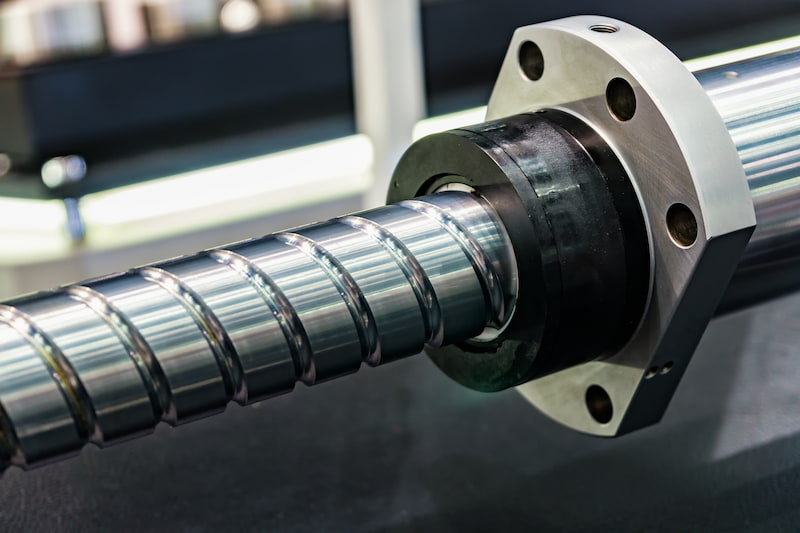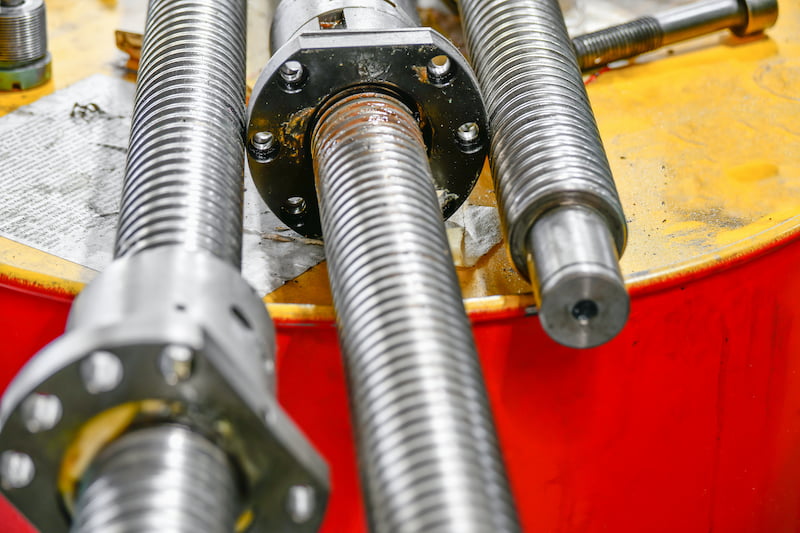A lead screw is a type of mechanical power transmission used in machines for high-precision actuation. It converts rotational motion into linear motion. Other names for a lead screw (or leadscrew) are power screw and translation screw.
Lead screws are sometimes confused with threaded rods. Although they might look identical to an untrained eye, the threads on a threaded rod are a lot finer. Thus, increasing the risk of thread deformation under load.
In this article, we’ll take a closer look at different lead screw types, their design, use-cases, advantages and disadvantages. So let’s get to it.
What Is a Lead Screw?
Lead screw is a power transmission linkage used in modern machines. It can generate very high forces with a small moment, thus providing a large mechanical advantage. It can be thought of as a wedge wrapped around a cylindrical rod.
In applications such as screw jacks and mechanical presses, it is used to create large forces. They also find use in applications needing extremely precise motion transfer and control, such as linear actuators and linear stages.
As the sliding contact area between the screw and the nut is high, a lead screw has more friction losses compared to other alternatives such as gear trains and chain drives. This characteristic generally limits a lead screw’s use to light- and medium-duty applications.
How Does a Lead Screw Work?
A lead screw works in one of two ways:
- The shaft is stationary and the power is supplied to the nut
- The shaft rotates and transfers power to the nut
In the first case, manually applied force or a motor rotates the nut. This pushes the nut along the shaft’s axis. Ultimately, the torque applied to the nut is transformed into linear motion.
In the second case, the nut’s rotational motion is restricted and the screw shaft rotates. The nut moves along the screw axis in the process. Thus, the torque on the screw shaft converts into linear motion of the nut.
Lead Screw Components
The lead screw itself is a small component in many complex assemblies. But even a basic lead screw can be broken down into three main components/features. These are:
- Screw shaft
- Threads
- Nut
The screw shaft is a cylindrical rod with threads or grooves along its length. At times, it may be referred to as an ACME rod, buttress rod or square-threaded rod as per the thread geometry. The most common materials used for lead screw shafts are carbon steel, stainless steel and aluminum. PTFE-based coatings are often used in harsh environments for durability and to remove the need for oil and grease.
The threads are present on the screw shaft and the nut. Although it is not a separate component in itself, the thread’s structure is responsible for converting rotational motion into linear motion. The external threads are in direct contact and mesh with the nut’s internal threads.
The nut is a fairly simple component but does not offer much use by itself. Typically, it will have some means, such as tapped or through holes, to connect it to supporting components like a clamp. The clamp connects the nut to a guide rail, restricting the nut’s rotation and only allowing linear motion. Nuts can be made from plastic or bronze to add self-lubricating properties.
Apart from these components, lead screws may require additional parts depending on the function. For instance, to control backlash, precision lead screws are fitted with loaded springs that create an axial load to prevent unintended axial movements.
- Personal account manager
- Quality assurance
- Payment terms for companies
- On-time delivery by Fractory
Lead Screw Design
The lead screw is a fairly straightforward actuator with few components and a simple yet effective design. But an engineer must be aware of certain lead screw terminologies to understand, manage and develop products that use lead screws. The following terms come up in lead screw design.
Crest and root
For a lead screw, the top of the thread is known as the crest. Similarly, the base of the thread where it connects to the screw shaft is known as the root of the lead screw.
Major, minor and pitch diameter
Major diameter is the distance of the thread crest from the shaft’s center axis measured perpendicular to the axis. Minor diameter is the distance of the thread root from the center axis. Pitch diameter is the diameter at which the screw threads contact the threads on the nut.
Helix and lead angle
The angle formed between the helical thread with the perpendicular axis of the lead screw shaft is known as the helix angle. A larger helix angle requires more torque to move the nut but it results in lower friction losses, thus making the setup more efficient.
The lead angle is the complementary angle of the helix angle. It is the angle between the helical thread and the axis of rotation.
Number of starts
A start refers to the starting point of a thread at the end of the screw shaft. When greater speeds and loads are required of the lead screw system, the screw shaft may have more than one start. It may have one, two, or four starts. Screws with multiple starts are basically independent threads running parallel to each other in the helical path around the shaft.
Screw lead and pitch
Screw lead is the linear distance moved by the nut in one revolution (360°) of the nut or the shaft. The smaller the lead, the tighter the thread, resulting in more precise linear motion.
The pitch is the distance between two adjacent crests or troughs measured parallel to the axis of rotation.
For single start screws, lead and pitch values are equal. In the case of multiple starts, the pitch is multiplied by the number of starts to obtain the lead.
Types of Lead Screw Threads

Lead screws are classified on the basis of their thread geometry. Threads used in lead screws must have high precision, accuracy and strength. Three of the most common types of threads used in lead screws are:
- Square thread
- Acme thread
- Buttress thread
Square thread
The square thread has square-shaped threads whose flanks are perpendicular to the axis of the lead screw. This 0° thread angle prevents any radial pressure on components and reduces friction between them.
This design also minimises the contact surface between the nut and the screw. Thus, square threads have the lowest friction losses and the highest efficiency. As a result, they provide greater load-bearing capabilities for the same dimensions or require smaller motors for the same load transfer. Square threads are, therefore, the first choice in motion transfer and heavy load applications.
Square threads are also desirable in products that need to be compact in size while maintaining their functional requirements. However, these threads are the most difficult and expensive to machine out of all the different types. In most cases, they require a single-point cutting tool for fabrication.
Acme thread
The acme thread is a trapezoid-shaped thread with a thread angle of 29°. It is based on the imperial standard but is accepted throughout the world.
This thread was developed as a stronger alternative to the square thread. Due to the sharp 90° angle between the flank and the root, square threads are relatively weak at the base. Widening the base adds strength as well as makes it easier to machine. Multi-point cutting tools can be used more easily to machine acme threads than square threads.
Many times, acme threads are incorrectly referred to as trapezoidal threads. The trapezoidal thread follows the metric standard and has a thread angle of 30°. The exact specifications for trapezoidal threads can be found under DIN 103.
Buttress thread
The buttress thread is a triangular-shaped thread that is used when force needs to be transmitted in one direction only. It has a 7° inclination on the load flank and a 45° inclination on the trailing flank.
Such a steep inclination enables it to carry the load as efficiently as square threads, while the trailing flank adds additional strength thanks to the wider base. This thread is also very precise and can be used to create small, accurate movements in one direction. Buttress threads exhibit poor performance when the axial load is applied in the other direction.
Lead Screw Application Examples

Lead screws are available in virtually every size and thus, they serve in a wide range of applications. In day-to-day use, lead screws are found in appliances such as printers, disc drives, lifting equipment and robots.
In industries, lead screws are present in machines such as lathes, vices, jacks and CNC machines. Processes like engraving, fluid handling, data storage, rapid prototyping, 3D printing, measuring and inspection rely extensively on high-precision lead screws.
The smallest commercially available lead screws can be as small as 0.5 mm in diameter. But for special cases, modern manufacturing methods can fabricate lead screws even smaller in dimensions. These special screws are used in medical devices for automated surgery and drug delivery. The medical industry also requires precision lead screws for medical imaging equipment such as X-ray, MRI, IMRT, PET and CT scan machines.
The Difference Between a Lead Screw and a Ball Screw

Ball screws are an alternative to lead screws offering similar functions. Sometimes they are even categorised as a type of leadscrew. The decision of whether to choose a ball screw or a lead screw can be a confusing one because of the similarities between the two.
Ball screw uses metal balls found in ball bearings for motion transfer. Instead of having internal threads, ball screws house balls in the lead screw nut. These balls fit into the grooves on the screw and are responsible for power and motion transfer. The balls have a small contact area with the lead screw shaft, resulting in very low friction. This reduces running temperatures and imparts high efficiency. A ball screw also has higher positional accuracy, speed and lead options.
The main drawbacks of ball screws are that they are expensive, don’t have self-locking properties and are not as shock-resistant as lead screws. They’re generally also a bit bulkier than lead screws and are
How to Select the Right Power Screw for Your Application
Every application is unique. The designer must understand the constraints and the service conditions before making a decision. This selection will not only affect the product design but also dictate the overall system performance.
However, due to the wide variety of screw types and sizes, choosing the right one can be a daunting task. Here’s an overview of the most important power screw features to consider when making the selection.
Load capacity
The load capacity of a power screw is the most important factor in the selection process. The service load affects many power screw features. For starters, the diameter of a lead screw is directly proportional to the required thrust.
There are two types of loads – peak and continuous. Peak load refers to high forces during sudden acceleration or deceleration and can be up to five times the continuous load. Continuous load is a calculated average value (RMS value) and sometimes applies consistently over the nut’s entire travel distance. It also directly affects the L10 life of a component. An engineer must consider both values and go for a design that can manage all the expected loads.
Plastic lead screw nuts can comfortably handle loads up to 50 kg, but they can be designed to manage up to 150 kg loads. On the other hand, bronze leadscrew nuts can handle several tonnes.
Speed
The second most important factor in power screw selection is speed. The speed at which a nut rotates or translates can be controlled by its helix angle and diameter. A small helix angle and a large diameter will reduce the linear and rotational speed, respectively.
Low speeds mean low operating temperatures, preventing any need for reducing the duty cycle. Operating speed is limited by the critical speed of the power screw. When exceeding this critical rpm (revolutions per minute), excessive shaft vibrations will affect the function and safety of the components. It is generally recommended that the operational speed does not exceed 80% of the evaluated critical speed.
Pressure-velocity factor
Pressure-velocity or the PV factor is an important parameter that expresses the actual load on a power screw. It is the combination of contact surface pressure and sliding velocity between the screw shaft and the nut. It is the key design parameter for lead screw assemblies using polymer nuts.
As the load increases, the rpm must be reduced to prevent permanent damage due to frictional heat. The opposite is also true, more speed means less available load capacity.
By ensuring that the actual PV value is less than the PV limit of the chosen material, we can warrant a longer service life.
Lubrication
Lubrication can be an issue with power screws, especially with those working under heavy loads and/or high speeds. The service environment conditions would need to be evaluated to make an appropriate selection in this regard.
In environments with high debris or particulate concentration, contaminated grease can actually cause abrasion. But lubrication is still necessary to prevent overheating, increase loading potential and improve service life.
In such cases, one option is to either clean the grease along with the particles and reapply the film. Or use a dry film lubricant. Even bronze nuts with self-lubricating features need damping grease for satisfactory function. Analysing the service environment and the functional demands will help with selecting the appropriate power screw for your application.
Besides the above-mentioned factors, parameters such as backlash, service life, efficiency, accuracy, repeatability, material, resolution and the extent of customisation required can help further narrow down suitable choices when selecting lead screws.
Advantages of Lead Screws
- Lead screws are cheap and reliable as they only have a few parts
- They require little to no maintenance
- Smooth and quiet operation
- Capable of lifting heavy loads
- Some power screws have self-locking property
- Low pitch screws can give highly precise measurements, which are vital in machine tool applications
Disadvantages of Lead Screws
- In comparison to other mechanical power transmission methods, leadscrews have a high wear rate
- Not suitable for applications with a very high torque demand
- They have relatively poor efficiency



